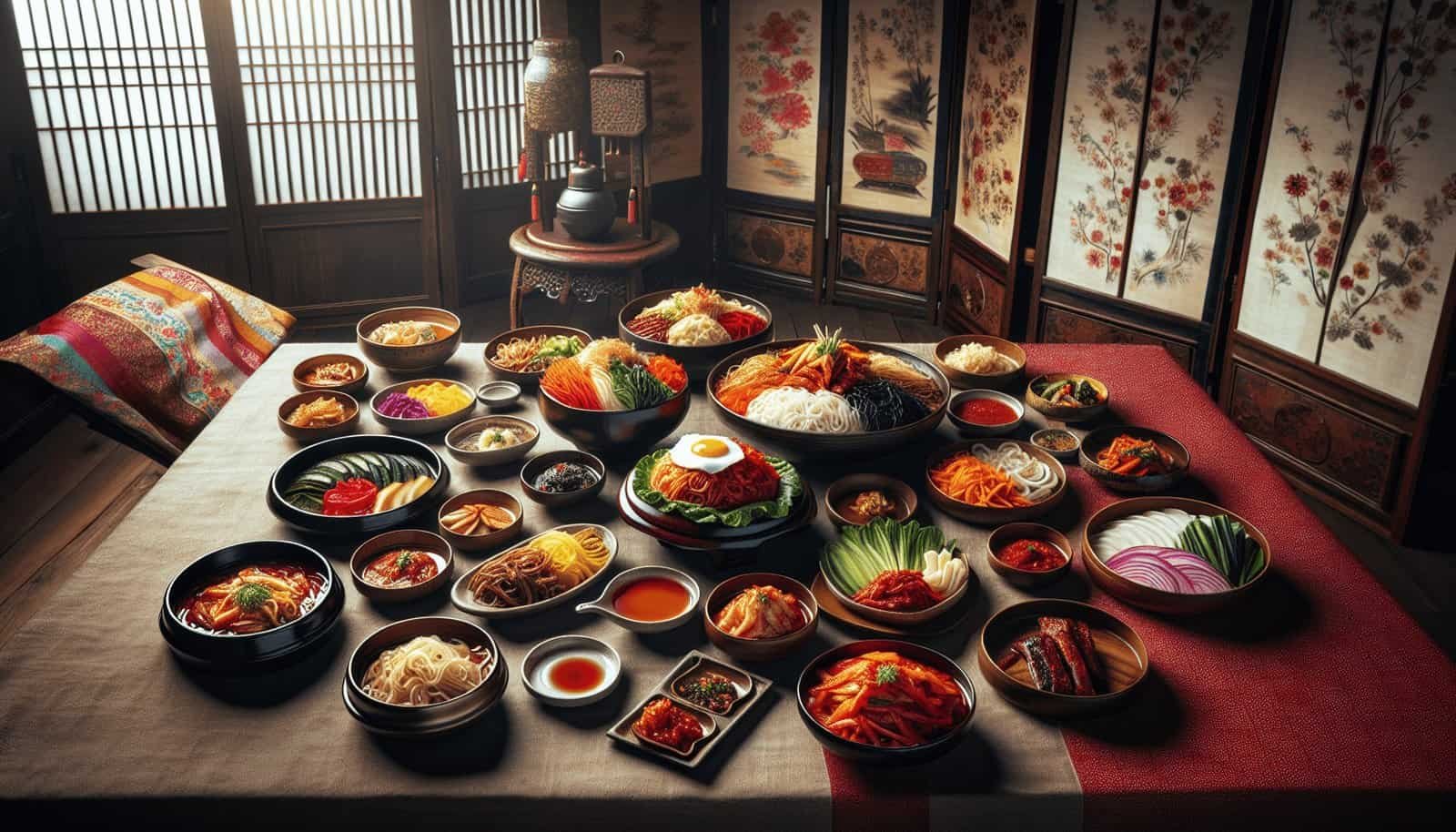Ready to embark on a culinary journey through the flavors of Korea? In this article, “Can You Recommend Traditional Korean Dishes That Are Suitable For A Hanjeongsik (full-course Meal)?” you’ll discover an array of delightful dishes that form part of a traditional Hanjeongsik. From savory starters like kimchi and jeon to hearty mains such as bulgogi and galbi, and finishing with sweet treats like yakgwa, you’ll find a harmonious blend of tastes and textures that promise to enchant your palate and satisfy your hunger. So, let’s dive in and explore the vibrant world of Korean cuisine!
Can You Recommend Traditional Korean Dishes That Are Suitable For A Hanjeongsik (Full-Course Meal)?
Have you ever wondered what it would be like to experience a full-course Korean meal, also known as Hanjeongsik? Whether you’re a seasoned food enthusiast or just starting your journey into Korean cuisine, you’re in for a treat. Let’s dive into the world of Hanjeongsik and explore the traditional dishes that make this dining experience truly unforgettable.
Understanding Hanjeongsik
Before we go into the recommended dishes, it’s essential to understand the essence of Hanjeongsik. Hanjeongsik is a traditional Korean meal that consists of multiple courses, offering a delightful variety of flavors, textures, and aromas. It’s a culinary journey meant to showcase the richness of Korean cuisine in a structured yet harmonious way.
The Importance of Balance
One of the key principles of Hanjeongsik is balance. Each course is carefully chosen to complement the others, offering an array of tastes—sweet, savory, spicy, and everything in between. The meal usually includes rice, soup, and multiple side dishes (banchan). This balance is not just about flavors but also about nutritional value, ensuring that the meal is as wholesome as it is delicious.
A Feast for the Senses
Hanjeongsik is not just about food; it’s an experience for all the senses. The presentation is often stunning, with dishes served in beautiful, ornate bowls and plates. The meal aims to provide a holistic experience, offering visual, olfactory, and tactile pleasures along with the taste.

Recommended Traditional Dishes for Hanjeongsik
Now that you know what Hanjeongsik is all about, let’s move on to the star of the show— the dishes. Below, I’ve laid out a variety of traditional Korean dishes suitable for a sumptuous Hanjeongsik meal.
Appetizers (Jeonchae)
Start your meal with some delightful appetizers that set the stage for what’s to come.
Bulgogi (불고기)
Bulgogi is perhaps one of the most well-known Korean dishes worldwide. It’s made by marinating thin slices of beef in a mixture of soy sauce, sugar, sesame oil, garlic, and other seasonings before grilling.
Ingredients:
- Thinly sliced beef
- Soy sauce
- Sugar
- Sesamer Oil
- Garlic
Japchae (잡채)
Japchae is a popular Korean noodle dish made from sweet potato starch noodles, stir-fried with vegetables and flavored with soy sauce and sesame oil. It’s slightly sweet and very satisfying.
Ingredients:
- Sweet potato starch noodles
- Various vegetables (carrot, spinach, mushrooms)
- Soy sauce
- Sesame oil
Main Courses (Jungsik)
The main courses are the heart of the meal, offering rich and diverse flavors.
Bibimbap (비빔밥)
Bibimbap is a classic Korean rice dish topped with various vegetables, a fried egg, and gochujang (Korean chili paste). It’s usually served in a hot stone bowl to keep it warm.
Ingredients:
- White rice
- Various vegetables (carrot, spinach, mushrooms)
- Fried egg
- Gochujang
Galbi (갈비)
Galbi, or Korean BBQ ribs, are marinated in a savory sauce that usually includes soy sauce, garlic, and sugar. They are traditionally grilled at the table, providing a hands-on dining experience.
Ingredients:
- Beef short ribs
- Soy sauce
- Garlic
- Sugar
Soups and Stews (Jeongol)
No Hanjeongsik meal is complete without a steaming bowl of soup or stew.
Kimchi Jjigae (김치찌개)
Kimchi jjigae is a hearty soup made with kimchi, tofu, pork, and various vegetables. It’s spicy and tangy, offering a comforting warmth.
Ingredients:
- Kimchi
- Tofu
- Pork
- Various vegetables
Samgyetang (삼계탕)
Samgyetang, or ginseng chicken soup, is a nutritious dish made by boiling a whole young chicken stuffed with glutinous rice, garlic, jujube, and ginseng in water.
Ingredients:
- Whole young chicken
- Glutinous rice
- Garlic
- Jujube
- Ginseng
Side Dishes (Banchan)
Side dishes are an integral part of Hanjeongsik, adding variety and depth to the meal.
Kimchi (김치)
Kimchi is not just a side dish but an essential part of Korean cuisine. It’s made by fermenting cabbage and radishes with chili powder, garlic, ginger, and other seasonings.
Ingredients:
- Napa cabbage
- Radishes
- Chili powder
- Garlic
- Ginger
Gyeran Jjim (계란찜)
Gyeran jjim is a fluffy steamed egg dish that is simple yet delicious. It’s seasoned with sesame oil and topped with green onions.
Ingredients:
- Eggs
- Sesame oil
- Green onions
Desserts (Hujeongsik)
Finish your Hanjeongsik meal on a sweet note with traditional Korean desserts.
Hotteok (호떡)
Hotteok are sweet Korean pancakes filled with brown sugar, honey, chopped peanuts, and cinnamon. They’re usually enjoyed hot and make for a delightful end to the meal.
Ingredients:
- Pancake batter
- Brown sugar
- Honey
- Chopped peanuts
- Cinnamon
Yakgwa (약과)
Yakgwa are honey cookies that are deep-fried and soaked in a honey-ginger syrup. They have a chewy texture and a unique, aromatic flavor.
Ingredients:
- Wheat flour
- Sesame oil
- Honey
- Ginger syrup

Creating Your Own Hanjeongsik Experience
You might be wondering how to bring all these elements together to create your own unforgettable Hanjeongsik meal. Let’s break it down step-by-step.
Planning Your Grocery List
Before you start cooking, you’ll need to gather all the ingredients. Here’s a basic list to help you get started:
| Category | Ingredients |
|---|---|
| Proteins | Beef, chicken, pork, tofu |
| Vegetables | Spinach, carrots, napa cabbage, radishes |
| Seasonings | Soy sauce, sesame oil, garlic, ginger |
| Starches | Rice, sweet potato noodles |
| Others | Gochujang, kimchi, honey, jujube, ginseng |
Cooking Tips
- Prep in Advance: Many of these dishes require marinating or fermenting, so plan your prep time accordingly.
- Multi-Task: Use your cooking time efficiently by working on different dishes simultaneously. For example, let the soup simmer while you prepare the side dishes.
- Presentation Matters: Don’t forget the importance of presentation in Hanjeongsik. Use your best dishes and make sure each course is visually appealing.
Serving Your Hanjeongsik
When it comes to serving the meal, layout is crucial. Here’s a typical way to set the table:
| Course | Dishes |
|---|---|
| Appetizers | Bulgogi, Japchae |
| Main Courses | Bibimbap, Galbi |
| Soups/Stews | Kimchi jjigae, Samgyetang |
| Side Dishes | Kimchi, Gyeran Jjim |
| Desserts | Hotteok, Yakgwa |
Serve each course sequentially or all at once, depending on your preference. The goal is to ensure a balanced and harmonious dining experience.
Pairing with Drinks
For an authentic touch, consider pairing your meal with traditional Korean drinks like soju, makgeolli (Korean rice wine), or Korean teas like boricha (barley tea) and insamcha (ginseng tea).

Cultural Significance of Hanjeongsik
Hanjeongsik is more than just a meal; it’s a cultural experience that reflects the heart and soul of Korean traditions. This dining format has evolved over centuries, influenced by the seasons, regional ingredients, and the importance of communal dining.
Seasonal Ingredients
Many of the dishes in Hanjeongsik use seasonal ingredients, celebrating the bounty of each season. For example, summer meals might feature lighter dishes with fresh vegetables, while winter meals are more likely to include hearty stews and soups.
Communal Dining
Korean cuisine emphasizes sharing, which is evident in the way Hanjeongsik is served. Large platters are placed in the center of the table for everyone to share, fostering a sense of community and togetherness.
Traditional Table Setting
A traditional Korean table setting (sangjeong) often involves specific placements of dishes and utensils, reflecting the values of balance and harmony. Rice and soup are typically placed in front of each diner, while the side dishes are arranged around them.

Conclusion
Creating a Hanjeongsik meal at home is a rewarding experience that will not only impress your guests but also deepen your appreciation for Korean culture and cuisine. From the tantalizing starters to the satisfying main courses and delightful desserts, Hanjeongsik offers a full spectrum of flavors and experiences.
So, what are you waiting for? Gather your ingredients, set your table, and embark on a culinary adventure that will stay with you long after the last bite. Enjoy your meal—Jal meokkesseumnida!

